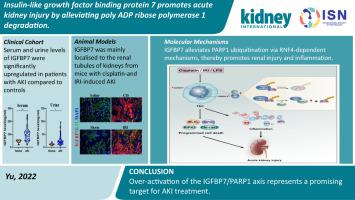Kidney International ( IF 14.8 ) Pub Date : 2022-06-23 , DOI: 10.1016/j.kint.2022.05.026 Ju-Tao Yu 1 , Xiao-Wei Hu 2 , Qin Yang 3 , Run-Run Shan 4 , Yao Zhang 1 , Ze-Hui Dong 1 , Hai-di Li 1 , Jia-Nan Wang 1 , Chao Li 1 , Shuai-Shuai Xie 1 , Yu-Hang Dong 1 , Wei-Jian Ni 1 , Ling Jiang 5 , Xue-Qi Liu 5 , Biao Wei 1 , Jia-Gen Wen 1 , Ming-Ming Liu 1 , Qi Chen 4 , Ya-Ru Yang 6 , Gui-Yang Zhang 7 , Hong-Mei Zang 1 , Juan Jin 7 , Yong-Gui Wu 5 , Xiang Zhong 8 , Jun Li 1 , Wei Wang 9 , Xiao-Ming Meng 1

|
The novel biomarker, insulin-like growth factor binding protein 7 (IGFBP7), is used clinically to predict different types of acute kidney injury (AKI) and has drawn significant attention as a urinary biomarker. However, as a secreted protein in the circulation of patients with AKI, it is unclear whether IGFBP7 acts as a key regulator in AKI progression, and if mechanisms underlying its upregulation still need to be determined. Here we found that IGFBP7 is highly expressed in the blood and urine of patients and mice with AKI, possibly via a c-Jun-dependent mechanism, and is positively correlated with kidney dysfunction. Global knockout of IGFBP7 ameliorated kidney dysfunction, inflammatory responses, and programmed cell death in murine models of cisplatin-, kidney ischemia/reperfusion-, and lipopolysaccharide-induced AKI. IGFBP7 mainly originated from kidney tubular epithelial cells. Conditional knockout of IGFBP7 from the kidney protected against AKI. By contrast, rescue of IGFBP7 expression in IGFBP7-knockout mice restored kidney damage and inflammation. IGFBP7 function was determined in vitro using recombinant IGFBP7 protein, IGFBP7 knockdown, or overexpression. Additionally, IGFBP7 was found to bind to poly [ADP-ribose] polymerase 1 (PARP1) and inhibit its degradation by antagonizing the E3 ubiquitin ligase ring finger protein 4 (RNF4). Thus, IGFBP7 in circulation acts as a biomarker and key mediator of AKI by inhibiting RNF4/PARP1-mediated tubular injury and inflammation. Hence, over-activation of the IGFBP7/PARP1 axis represents a promising target for AKI treatment.
中文翻译:

胰岛素样生长因子结合蛋白 7 通过减轻聚 ADP 核糖聚合酶 1 降解促进急性肾损伤
新型生物标志物胰岛素样生长因子结合蛋白 7 (IGFBP7) 在临床上用于预测不同类型的急性肾损伤 (AKI),并作为尿液生物标志物引起了广泛关注。然而,作为 AKI 患者循环中的一种分泌蛋白,IGFBP7 是否作为 AKI 进展的关键调节因子尚不清楚,其上调的机制是否仍需要确定。在这里,我们发现 IGFBP7 在 AKI 患者和小鼠的血液和尿液中高表达,可能通过 c-Jun 依赖机制,并且与肾功能障碍呈正相关. 在顺铂、肾缺血/再灌注和脂多糖诱导的 AKI 小鼠模型中,IGFBP7 的整体敲除改善了肾功能障碍、炎症反应和程序性细胞死亡。IGFBP7主要来源于肾小管上皮细胞。从肾脏中有条件地敲除 IGFBP7 可预防 AKI。相比之下,在 IGFBP7 基因敲除小鼠中拯救 IGFBP7 表达可以恢复肾脏损伤和炎症。IGFBP7 功能在体外测定使用重组 IGFBP7 蛋白、IGFBP7 敲低或过表达。此外,发现 IGFBP7 与聚 [ADP-核糖] 聚合酶 1 (PARP1) 结合并通过拮抗 E3 泛素连接酶环指蛋白 4 (RNF4) 来抑制其降解。因此,循环中的 IGFBP7 通过抑制 RNF4/PARP1 介导的肾小管损伤和炎症,充当 AKI 的生物标志物和关键介质。因此,IGFBP7/PARP1 轴的过度激活代表了 AKI 治疗的一个有希望的目标。











































 京公网安备 11010802027423号
京公网安备 11010802027423号